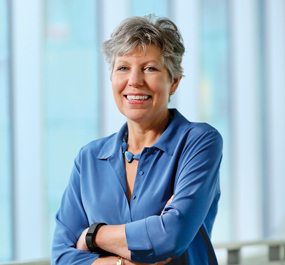Letter From the Editor

Mike Lovett
Laura Gardner, P’12
Even as a fledgling museum, the Rose made an outsized mark on the art world, thanks in large part to founding director Sam Hunter. In 1962, a year after the Rose was launched, Hunter was asked to build a contemporary-art collection with the help of a $50,000 gift from New York donor Leon Mnuchin and his wife, Harriet Gevirtz-Mnuchin.
Hunter and Mnuchin, as the story goes, went to New York galleries and artist studios, spending no more than $5,000 on any individual artwork. A visionary with an uncanny knack for spotting emerging talent and trends, Hunter helped build the young Rose into a contemporary-art powerhouse by acquiring early and important works by Jim Dine, Jasper Johns, Ellsworth Kelly, Roy Lichtenstein, Marisol, Claes Oldenburg, Robert Rauschenberg, James Rosenquist, Andy Warhol and others.
Today, as the Rose celebrates 60 years with a provocative anniversary exhibition of the permanent collection, it seems to be channeling Hunter’s legendary brio and daring, but with many unexpected twists and turns. Director Gannit Ankori, the first woman to head the Rose, has made “re: collections, Six Decades at the Rose Art Museum” as much about marginalized artists (mostly by showcasing the museum’s more-recent acquisitions) as about the titans Hunter identified long before their art was worth millions.
In “The Art of Disruption,” Ankori explains that the exhibition pays tribute to the Rose’s pioneering history as it questions who has historically been left out of museums — namely, artists of color, LGBTQ artists and female artists. By pairing lesser-known painters, sculptors and photographers with blue-chip names, the show invites us to reconsider artists and artworks in a new, more complex and sometimes disturbing light.
Questioning convenient beliefs, in fact, is one of this issue’s themes. “The Examined Life” profiles journalist and Pulitzer Prize nominee Elizabeth Bruenig ’13, who is most comfortable when she’s discomforting her readers. A devout Catholic and European-style democratic socialist, who recently moved from a post at The New York Times to The Atlantic, Bruenig explores guilt and redemption while grappling compassionately with knotty moral issues, like capital punishment and sexual assault.
Uncovering self-serving beliefs of another kind is at the core of “Diversity’s Fault Lines,” a story about sociologist Sarah Mayorga’s research. She discovered that affluent, liberal whites in Durham, North Carolina, were quick to say they valued living in a diverse community yet avoided meaningful interaction with the people of color who were their neighbors. Mayorga tries to pinpoint what’s behind this disconnect.
With every issue of the magazine, our goal remains the same: to engage and inform you, and strengthen your ties to Brandeis. Please tell us how we’re doing, so we can give you more of what you want and need from your alumni magazine.
Best,
Laura Gardner, P’12
Editor-in-Chief
